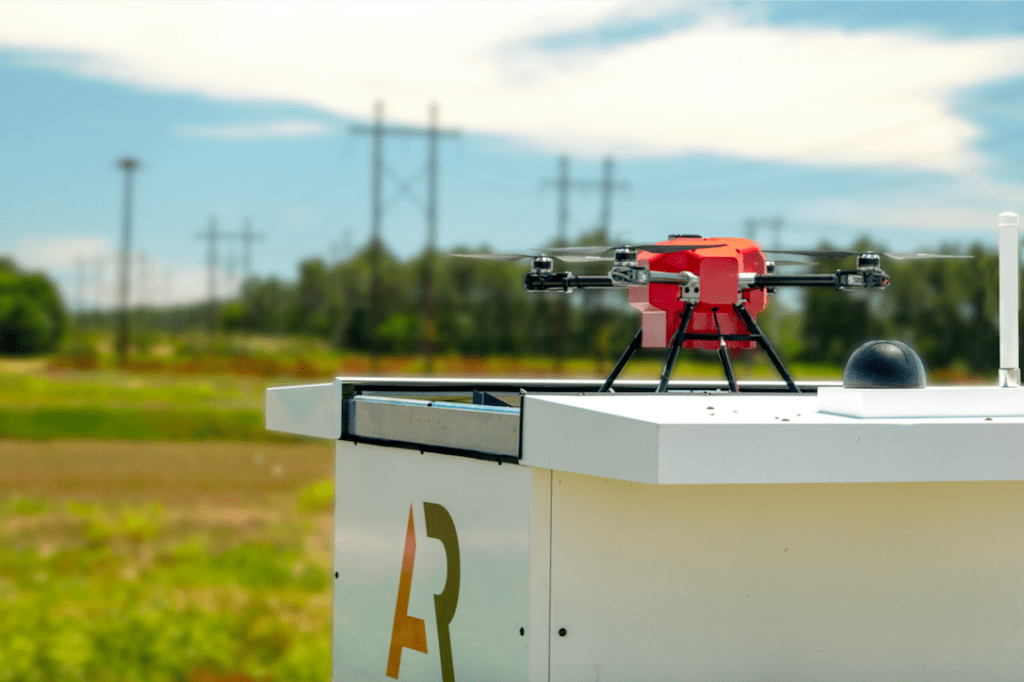
The Scout System works with a base, the ScoutBase, an artificial intelligence (AI) powered Scout unmanned aircraft system (UAS), and a secure web portal, ScoutView, that interacts with the system storing data and analytics. (American Robotics)
The Federal Aviation Administration (FAA) made its first approval of automated drone operations without human pilots or observers on-site. The drones use an aerial intelligence platform, the Scout System, equipped with acoustic Detect-and-Avoid (DAA) technology and a layered redundant safety algorithm created by American Robotics to conduct beyond visual line of sight (BVLOS) flights in the national airspace system, the company announced on Jan. 15.
The Scout System works with a base, the ScoutBase, an artificial intelligence (AI) powered Scout unmanned aircraft system (UAS), and a secure web portal, ScoutView, that interacts with the system storing data and analytics. The DAA technology and safety algorithms allow the UAS to operate safely BVLOS.
“The Scout System employs multiple risk mitigations including advanced real-time sensors and algorithms that provide various safety and reliability functions including Detect-and-Avoid (DAA) of other aircraft and obstacles, automated real-time system diagnostics and fail-safes, and automated flight mission management,” Vijay Somandepalli, American Robotics’ CTO, told Avionics International. “If anything were to deviate from the expected, safe operation plan, our drone systems automatically take immediate action to correct, such as altering its flight course and landing, as necessary to maintain safety.”
The current approvals allow one base system to power one UAS which can operate within a couple of miles of each other, Somandepalli said. However, the remote pilot can be as far away as a few states.
“With its ground-based acoustic DAA sensors, the Scout drone can operate multiple miles away from ScoutBase,” Somandepalli said. “Scout systems can be remotely monitored and piloted from thousands of miles away. For example, with our approvals, we are able to install Scout systems in Nevada and Kansas, and remotely operate them from Boston, MA without needing local pilots or visual observers (VOs).”

The current approvals allow one base system to power one UAS which can operate within a couple miles of each other. (American Robotics)
The distance between which the UAS and ScoutBase can operate was based on where the DAA sensors and algorithms met performance standards set by the FAA and industry, according to American Robotics. The Scout System allows UAS to fly below 400 feet in rural areas approved by the FAA.
“The ground-based acoustic DAA technology we use in the Scout system is able to detect and track aircraft out to several miles even at low altitudes where other traditional sensors such as radars struggle with issues like clutter,” Somandepalli said. “The entire Scout system has undergone rigorous and extensive testing and validation in the field in real-life conditions to ensure that it can operate safely and harmoniously in the NAS with other aircraft.”
Previous FAA waivers allowed drones to fly alone flight paths with visual observers, however, this approval does not require the human component that others did. The Scout System maps and geofences an area where the UAS will operate prior to the flight and then the system worth autonomously while being monitored remotely, according to American Robotics.

The distance between which the UAS and ScoutBase can operate was based on where the DAA sensors and algorithms met performance standards set by the FAA and industry. (American Robotics)
The next step after this approval will be to expand operations so multiple UAS can be monitored at the same time creating a more autonomous system with less need for human interference.
“Under the present approvals, each Scout system must be monitored by an American Robotics staff pilot remotely,” Somandepalli said. “We are working with the FAA to expand this approval such that a staff pilot can monitor and operate a multitude of Scout systems simultaneously.”